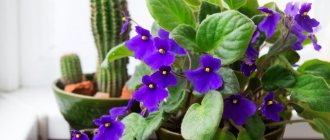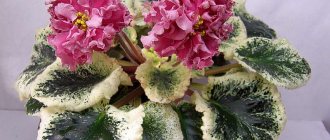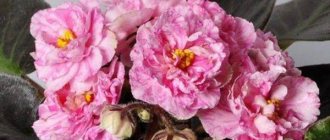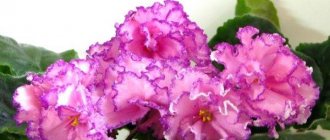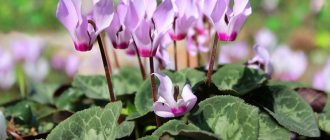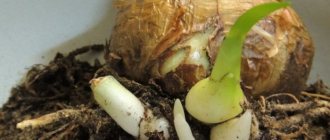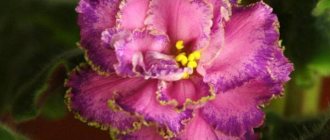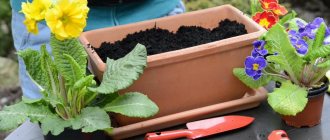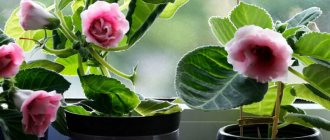The amazing violet variety “Goddess of Beauty” has earned the love of flower growers due to its rare beauty and unpretentiousness.
Dear readers!
For you, we have created communities on social networks in which useful articles and interesting ideas are published several times a day! Subscribe and receive useful content in a convenient format! One of the big advantages of this flower is its huge, approximately 7 centimeters, densely double inflorescences, pleasing the eye of even the most fastidious connoisseurs of beauty. Its flowers are double, and the edges of the petals are wavy - to obtain this result, the breeder had to put in a lot of effort, and it fully justified itself. Such a flower simply cannot fail to attract attention!
You can grow such a flower from just one leaf, but in order to get lush beautiful flowers, and not just leaves, you need to know how to care for it.
Description of the variety
The unusual and beautiful violet variety “Goddess of Beauty” really deserves the love and attention of flower growers.
In this article you will learn in detail how to grow it correctly and how to make it please its owners with lush, bright flowers for as long as possible, and how to treat it in case of illness
This indoor flower was bred in 2003 in Togliatti by Elena Vasilyevna Korshunova , who became famous thanks to her successful experiments in the field of selection. All varieties bred by her are affectionately called “kite kites” by breeders and flower growers. One of her best experiences was “Goddess of Beauty.”
Interesting! The varieties bred by Elena Korshunova have the prefix “EK-” in front of the name.
Leaves
Its leaves are plate-shaped, dark green, velvety.
They grow on long thin cuttings, spreading out in all directions. Some people recommend removing the lowest leaves for the sake of compactness, but this will not affect its health and flowering, so it remains a matter of taste and space options.
With age, the leaf rosette becomes smaller and loses its beauty, so it would not be superfluous to “rejuvenate” the flower every couple of years.
Flowers
It becomes especially beautiful, of course, during flowering.
Thanks to the efforts of breeders, its flowers reach amazing sizes - from seven to nine centimeters in diameter. There are a lot of color options: a variety of shades of pink with crimson, lilac, violet tints.
In some varieties, the ebbs cover the entire flower, in others they are located at the edge.
The only drawback of the flower is that the peduncles are too thin and long and cannot hold the heavy, beautiful inflorescences , which is why they gradually droop. But this drawback does not spoil the flower too much and even gives the “Goddess” tenderness and charm.
Important! This variety of violet cannot be planted in open ground even in the best climate: the delicate flower will not survive such changes.
Reviews
Tatiana Luneva. I have had this variety for a long time and can’t stop admiring it. Straight erect peduncles above the rosette distinguish this violet from others; it blooms for a long time, the flowers increase in size as they grow.
Tired Sun, K. Morev, photo by T. Lunev
Tired Sun, K. Morev, photo by T. Lunev
Tired Sun, K. Morev, photo by T. Lunev
- Login or register to post comments
Photo of violet EC “Goddess of Beauty”
Features of care
Like any plant, this variety needs certain conditions; let’s look at them in more detail.
Priming
The goddess prefers soils with turf, pine needles, peat and humus, and requires annual replanting to avoid infection, disease and mold. In order to simplify the choice of soil, you can simply purchase specialized soil for violets - it will be quite suitable for the plant.
Pot
The “Goddess of Beauty” has no special preferences in terms of pots; pots traditional for violets with a diameter three times smaller than the rosette of the plant are suitable - this is traditional for all violets; in too wide ones they grow poorly and almost do not bloom.
Don’t forget to put a little expanded clay or special moss on the bottom for drainage ; all this can be purchased at any flower shop.
Lighting
This variety of violets loves bright light without directly directed rays of the sun, as they cause burns and spotting in the delicate “goddesses.” For better flowering, experienced gardeners install lamps directly above them (fluorescent ones are best suited). They need 12 hours of light per day.
Attention! In order to understand that the plant needs more light, pay attention to the leaves: when a violet pulls its leaves up, it means that it does not have enough light.
Temperature
Violet does not require special temperature conditions: 20-24 degrees Celsius - normal conditions in an apartment - the ideal regime for violets. Similarly with humidity: no unnecessary manipulations, the conditions in the apartment are quite sufficient for active flowering and flower health.
Exhibition at the Violet House “New Year’s Tale 2017”
Dear friends, yesterday Svetlana Sazykina and I visited the exhibition at the Violet House “New Year's Tale 2017”. I hasten to share what I saw.
This was already the second day after the opening of the exhibition, there were not very many people and it was possible to take photographs calmly. I go to exhibitions in the DF twice a year, but more often it doesn’t work out... and that’s why it’s always a very pleasant event for me. This time there was only one Moscow group at the exhibition.
The girls organized a real Fairy Tale for violet lovers! A festive atmosphere reigned in the hall - Christmas tree garlands and New Year's toys hung on racks with violets, not to mention the wonderful specimens of violets that these violet fairies grew for this day. The atmosphere in the hall is festive, businesslike and friendly, the attendants are polite and attentive to incoming customers, helping to choose leaves from sockets or children. Through our website I would like to thank all these wonderful people who organized this holiday!
There will be a lot of photos, so there will be almost no comments, just look and admire.
Well, now I’m moving on to showing the exhibition rosettes, although some rosettes were left almost without leaves, only with bouquets of flowers:
Prize-winners of the exhibition:
Beloved by many, constantly blooming Frozen in Time:
ND-Northern Rhododendron - a chic bouquet of delicate flowers on a beautiful variegated rosette:
A constant participant in all recent exhibitions and my favorite:
AV-Bohemia, Violetflower - the color was poorly rendered, the flowers are very dark, velvety:
WaT-Amazon is a wonderful miracle, I couldn’t help but buy a cutting:
ND-Tales of Seydov, the poor rosette was left without leaves on the first day, the variety is new, very bright:
And I couldn’t pass by this variety:
A sea of flowers, not even a rosette in sight:
Snow-white, very large fluffy flowers:
LE-Tristan:
This variety has large terry bells with such an interesting color. I'll try to grow the same beauty:
Very cheerful fantasy specks on large delicate flowers:
AB-Terry Petunia, Violet Plant, the rosette was left completely without leaves on the first day:
WaT-Find the Cat:
And now the miniatures. True, there were not enough of them... And the racks on which they stood were not conducive to photographing. I was able to photograph something that stood closer to the edge, but I couldn’t take off those rosettes that were in the depths.
Permanently blooming trailer:
BR-Bimbo, cute large flowers. I couldn’t figure out whether the rosette was so compact, or whether it had been completely torn off. But, never mind, I’ll see for myself what I can come up with:
N-Dubrava. Like all varieties, N. Berdnikova seems to love to bloom, she also bought a cutting and couldn’t pass it by:
N-Evening Star, Berdnikova:
E. Lebetskaya’s original variety, semi-mini, I decided to try too:
That's all. If earlier at the exhibitions there were 80-90% of foreign varieties of violets, now 80-90% of the varieties are from ours and Ukrainian breeders, this is very pleasant. There are a lot of worthy varieties! Look and choose what you would like to have in your collections.
Flower propagation methods
The most popular and easiest way to propagate this variety is vegetative.
You just need to carefully cut off the leaf on the petiole with a disinfected blade. Afterwards, there are two options: in the first case, you just need to put it in water and wait until the roots appear.
When they appear, the plant can be planted in the ground.
To be more reliable, it is better to use ready-made soil, a peat tablet, a mixture of peat and vermiculite, or agroperlite. Then you can simply pour the prepared mixture into a small pot, up to 2.5 cm in radius, plant a leaf there, pour in clean, settled water and cover with cling film or a bag.
The mini-greenhouse needs to be ventilated every other day and watered if necessary, and when transplanting, open the greenhouse gradually.
Find out also about other varieties of violets on our website: “Southern Night”, “Sea Wolf”, “Chateau Brion”, “Dance of the Galaxies”, “Black Pearl”, “Angelica”, “LE Isadora”, “Duchess”, “ Winter smiles" and others.
Caring for the “goddess”
Violets are unpretentious in care, and this variety is quite easy to care for.
How to water?
It should be watered at the root with settled water, not cold or hot; in terms of spraying, the opinions of gardeners are divided.
Some people believe that violets should never be watered, while others are sure that regular bathing in warm water is good for the flower. Mostly people adhere to the first opinion.
Transfer
It is advisable to carry out transplantation once a year systematically or if necessary.
Just carefully remove the plant from the pot, carefully free the roots from the soil, remove the rotting roots, and then plant the plant in fresh soil in another pot.
Don't forget to place drainage at the bottom!
Top dressing
Instead of fertilizing, you can simply regularly replant the “Goddess of Beauty” into a slightly larger pot with fresh soil - in this case, it will feel great and decorate the room without any extra fertilizing or labor.
Peculiarities
Simple, but at the same time very beautiful variety. Large flowers abundantly fill the center of the rosette.
The delicate pink color of the flower pleasantly attracts the eye, and the dark pink spot in the center of the flower darkens and enlarges as the bud fully blooms.
The variety is easy to care for and blooms for a long time.
Tired Sun, K. Morev, photo by I. Polishchuk:
Tired Sun, K. Morev, photo by I. Polishchuk:
Tired Sun, K. Morev, photo by I. Polishchuk (autumn 2014):
Diseases and pests
Unpretentious and viable violets are still quite susceptible to various diseases.
“Goddesses of Beauty,” like all other violets, are at risk for many diseases, but proper plant care, regular and regulated watering and good lighting will allow your favorite flower to live as long as possible without causing trouble to the owner.
- Powdery mildew is a disease that prevents a plant from blooming. It appears from excess humidity and cold; the entire plant becomes covered with a grayish coating and subsequently black spots. This disease is easily treated with fungicides.
- Gray mold is a fungal disease, an eternal companion of low lighting and excessive watering. The violet is covered with a gray “web”, under which the leaves and stems begin to rot. For treatment, you need to treat the “Goddess” with antifungal drugs and cut off the infected parts of the plant.
- Spot is a disease in which the leaves and stems of a flower become covered with spots, this is the result of excess watering or exposure to direct sunlight. To solve the problem, it is enough to change the position of the flower, ridding it of direct rays of the sun, and adjust the watering.
- Late blight is an unpleasant disease, a fungus that causes plant roots to rot. Because of this, the leaves begin to dry out even with very abundant watering, and this is how the disease manifests itself externally to the plant owner. This is the result of excess moisture in the air and soil. Alas, plants that are sick with this cannot be saved, and the pots after them need to be sterilized
